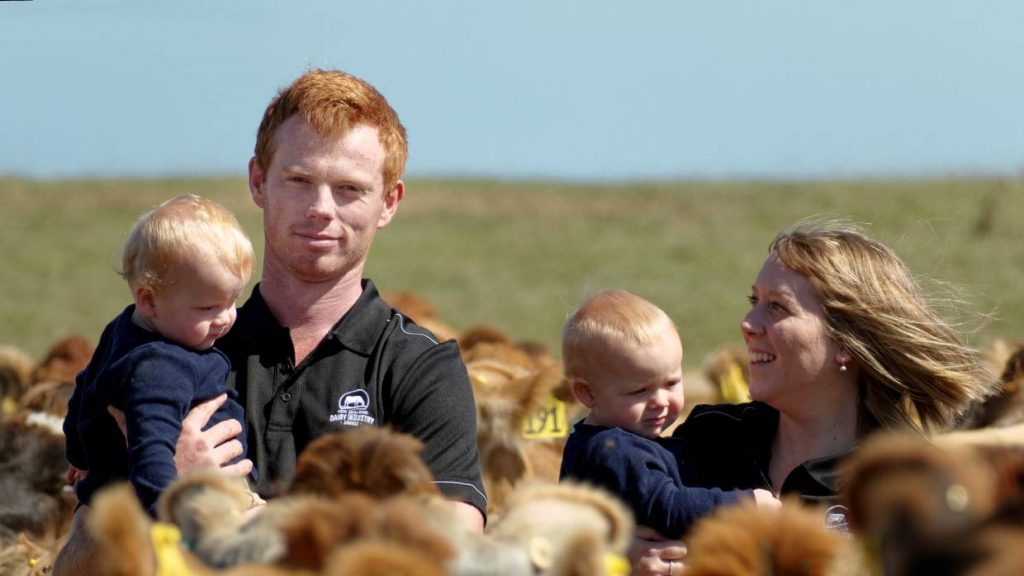Animal welfare should be the priority if farmers want to build a successful business, say a leading dairy farming couple.
A number of cases of mistreatment of animals have put the spotlight of some farmers and industry practices.
But for award-winning Taranaki sharemilkers Simon and Natasha Wilkes animal welfare simply makes good business sense.
In last summer’s dry heat the Wilkes’ dairy herd began to struggle, but pushing them to continue producing milk was not an option, Natasha Wilkes said.
“At that stage it’s not about making an extra dollar. Simon was like, ‘we need to get these cows resting, eating lots and preparing them for next season’,” Natasha Wilkes said.
The couple run 320 jersey cows on Natasha Wilkes’ parents farm near Hawera in Taranaki.
They won the sharefarmers of the year award at the Taranaki Dairy Industry Awards this year and consider their herd, which has been in Natasha Wilkes’ family for four generations, their greatest asset.
“Farming isn’t short-term, it’s long-term,” Simon Wilkes said.
If looked after well, a cow could be in the herd for at least 13 years but was most productive at age seven, he said.
The Ministry for Primary Industries provides a code of welfare for dairy cattle that outlines best practice. It covers stockmanship, feed and water, behaviour, the physical environment, husbandry practices and health.
But welfare also came down to being in tune with the herd in order to recognise issues an individual cow might have. And because the herd had been in the family for generations there was a strong emotional connection, they said.
It was hard to hear about instances of abuse or neglect in the dairy sector when the majority of farmers worked hard to ensure animals were well cared for, Simon Wilkes said.
“If you’re relaxed, they’re relaxed. And they remember things as well,” he said.
An injured animal from their farm would never be allowed to be transported, and if there was any doubt they would check with a vet, they said.
Dairy veterinarian Matt Stancombe said overall conditions for dairy cows had been improving rapidly as more was understood about best practices by both vets and farmers. There was also better preventative medicine available now, including mineral supplements.
He described Simon Wilkes as enthusiastic and keen to learn, participating in making health plans ahead of each season.
“He’s always happy to listen and take whatever he can from everyone he’s talking to. He’s trying to run stuff by best practice. If there’s something he can be doing better he wants to find out if he can do that,” Stancombe said.
The Wilkes worked to a plan that ensured the animals got what they needed at each stage of their life. They also had a yearly health plan that scheduled in things like vaccinations and mineral supplements. If it was scheduled, nothing got missed, they said.
For example, cows needed more calcium during calving to help produce colostrum, while calves needed to receive the colostrum within 12 hours of being born or they would lose out on the benefits, they said.
“It all comes down to management. There’s the big things you have on the calendar coming up but then there’s the day to day stuff. Making sure they have enough food and water,” Simon Wilkes said.
Simon Wilkes had also implemented regular body composition checks to log the ratio of muscle and fat on each animal. This way, if an animal was underweight it could be dried-off early, or milked just once a day, he said.
The main thing was to seek help and advice for things that were beyond a farmer’s skills or knowledge, he said.
The Wilkes used a vet to disbud calves who sedated them and administered local anaesthetic before their horns were removed. That ensured that the calf was less stressed and suffered less pain, Natasha Wilkes said.
Legally, only local anaesthetic was required.
Stancombe said disbudding had predominately been done by farmers “back in the day”, but now nearly all farmers employed vets and technicians for the procedure because it required knowledge of how to administer drugs.
Extending pain relief for cows had become better understood in recent years, he said.
“The gold standard now is to give a local anaesthetic, sedate them and give an anti-inflammatory afterwards.”
Not many farmers were using the anti-inflammatory yet, but Stancombe believed this would become more common in time.
Another new “gold standard” was minimising the use of antibiotics by only giving them to cows that really needed them.
Cows were now commonly tested when they were being dried-off and those that didn’t need antibiotics had a teat seal applied to prevent infection occurring, he said.
“Usage has gone up by about 50 per cent in the last four years and antibiotics have gone down by about 20 per cent,” he said.
There were outliers everywhere with regards to animal welfare, but it was very rare for neglect to be malicious. It was usually due to ignorance and lack of education, Stancombe said.













